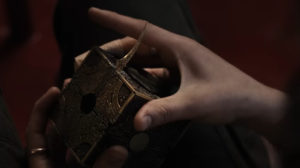Hellraiser (2022): All pain, no pleasure
Hellraiser (2022) had potential. It was billed as a reboot, not a sequel, of the longstanding “Hellraiser” franchise that’s been giddily goring out victims for our viewing pleasure since Clive Barker’s original 1987 movie. This new film is the eleventh in the franchise (the last seven entries were relegated to direct-to-DVD obscurity), resetting the story to a clean slate. Following the success of 2018’s Halloween reboot, Miramax Films announced plans to follow-through on releasing a “Hellraiser” redo that had been planned on-and-off as far back as 2007. But then, Clive Barker won the rights back to his franchise in 2020, announcing his intention to produce the new “Hellraiser” film that Miramax had been putting together. Now, after years of studio back-and-forth, the first entry of this new “Hellraiser” era has been released exclusively on Hulu—directed by David Bruckner, written by Ben Collins and Luke Piotrowski. This reboot shies away from directly adapting Clive Barker’s original Hellraiser (1987), instead focusing on an entirely new plot and cast of characters. The only hold-overs from previous entries are the franchise’s iconic Cenobite monsters and their ringleader, Pinhead. But after all this time, how does the new film hold up to the original? Well, unfortunately, the result is rather middling.

I’ll admit that I’m not a mega-fan of this franchise. I loved the original 1987 film and thought its direct sequel Hellbound: Hellraiser II was OK, but I haven’t watched any of the other entries. When I was watching this remake, I was mostly comparing it to the original, not the franchise as a whole. I’ve read that this film was better than most of the other many sequels, but as a re-interpretation of Barker’s cult-classic horror film, I found it sorely lacking. This was disappointing for a few reasons:
- While Barker’s original wasn’t able to be explicitly queer due to censorship concerns, Jamie Clayton, a trans woman, being cast as our central villain sparked my hope that queerness would finally be at the forefront for this modern retelling. I hoped that maybe a queer actress portraying Pinhead would open up the door for more overtly queer themes to influence the story.
- America may still be fairly conservative, but the social climate around sex and sexuality has loosened a lot since 1987. It felt almost like a guarantee that a modernized version of Hellraiser would lean into the themes of sadomasochism and dangerous pleasures much more intensely than its predecessor.
But on both of these counts, I was wrong.
It pains me to say this, but Hellraiser (2022) took the sex out of “Hellraiser”. Somehow, a theatrically released studio film from 1987 was more comfortable with exploring taboo aspects of sex and sexuality than a made-for-streaming film released in 2022. The original Hellraiser was, according to Clive Barker himself, directly influenced by S&M culture in underground nightclubs during the 1970s. The inspiration is plain-as-day—the Cenobites (extra-dimensional creatures who deal in pain and pleasure to the extreme) are dressed in gothic fetish gear, the human antagonists Frank and Julia combine violence and sex with feverish glee. Characters get pulled into the Cenobites’ puzzles because of their seductive promise of immense pleasure. At the core of 1987’s Hellraiser is a fascination with how pain and pleasure can intermingle, and how much pain one is willing to endure to get what they want. These themes are, for the most part, absent in the 2022 reboot. Instead, we get a fairly by-the-numbers story about seeking an impossible reunion with a lost sibling.
The film opens with Joey, a sex worker (which he doesn’t even get identified as until a throwaway line later in the film), getting lured into solving a mysterious puzzle box for the millionaire Roland Voight (Goran Višnjic). A blade stabs Joey’s hand when he solves the puzzle, and Joey is torn apart by chains and hooks that fly into the room from seemingly out-of-nowhere as Roland uses the solved box to summon Cenobites to his mansion. Seven years later, we’re introduced to Riley (Odessa A’zion), a recovering drug addict who lives with her brother Matt (Brandon Flynn), Matt’s boyfriend Colin (Adam Faison), and their roommate Nora (Aoife Hinds). Riley is dating Trevor (Drew Starkey), who she met at her 12-step program.
Trevor and Riley break into a huge shipping crate that Trevor found at an abandoned warehouse, hoping to make some money off of whatever they can find inside. In the crate, Riley and Trevor find only the same puzzle box we saw Joey solve in the beginning. Matt kicks Riley out of their apartment after learning about her and Trevor’s illicit adventure, causing Riley to relapse and get high at a park. Idly, she toys with the puzzle box as the drugs kick in, narrowly missing getting slashed by the blade that springs out of it. Finding his sister at the park, Matt accidentally cuts his hand on the box while Riley is unconscious, causing him to get taken by the summoned Cenobites. When Riley comes to, she makes it her mission to find her brother and solve the true nature of the mysterious puzzle box that keeps claiming victims.

Without spoiling too much, that’s the rough shape of the story we’re presented with here. There were elements that really could have worked well, but the film tends to discard ideas faster than the audience can keep up with. Riley’s drug addiction doesn’t return as a serious dimension to her character after Matt disappears, which is a shame—the struggle of vice and virtue inherent in any addiction is rife with material for the Cenobites to toy Riley with. In the original film, the conflict was driven by an insatiable lust for extreme feeling, where our human villains would kill and maim for pleasure and power. In Clive Barker’s film, power is presented as the chance to maximize every sensation, and the ability to control how and when you can extract pleasure from others. In this reboot, power is a vague concept that fumbles out of our characters’ mouths. Even the Cenobites feel disconnected from their roots. Pinhead (or, The Priest, as she’s credited in this film) and the other Cenobites speak of power and control without truly demonstrating it in a meaningful way. Just because the film shows me someone getting their back ripped off (yes, that does happen) doesn’t mean that the film is presenting me with a compelling villain or theme. Without drawing on the rich dichotomy of desire and agony, the violence feels hollow.
And this is a shame—Jamie Clayton’s performance as Pinhead/The Priest is fabulous. The other Cenobite performers put on a good show too—actress Selina Lo in particular plays The Gasp with a soft menace, stalking and toying with her victims wearing a smile. But the performers are let down by lackluster writing. Jamie Clayton’s Pinhead/The Priest is vulture-like, marking her prey and waiting for the right moment to sink her claws into them. She has an undeniable stage presence whenever she slinks into frame. It’s fun to watch her inhabit this role, but she’s never given the opportunity to become more than a generic slasher-film villain. She speaks of pleasure, but we’re never shown what it looks like. Her and her Cenobite cohort kill and maim left-to-right, but their reasons for doing so are almost entirely absent.

Rather than a re-imagining of a subversive cult-classic, Hellraiser (2022) is instead a generic slasher flick with a modicum of above-average gore. It’s thematically hollow, populated by flat characters, and is too afraid to go places that its predecessor proudly tread over 30 years ago. Explicit queer representation is nice to see, but it hardly goes beyond surface level—Riley’s brother Matt is in a gay relationship but we only get a few minutes to see the couple together before Matt vanishes; and none of the Cenobites complicate notions of gender or sexuality in either their presentation or behavior. And substituting sadomasochism for drug addiction would have been an interesting way to explore the pain/pleasure spectrum, but this film is too afraid to commit to that idea as well. At most, Hulu’s reboot offers horror fans a few gnarly death-scenes, visually engaging set pieces, and a sleek new design for an iconic villain. If those aren’t enough to draw you in, I recommend sticking to Clive Barker’s original 1987 version. Made with only a fraction of the remake’s budget, it’s far more imaginative and interesting.

